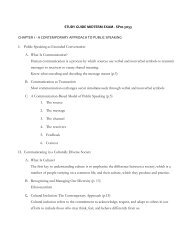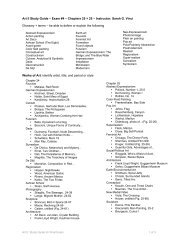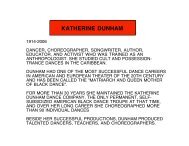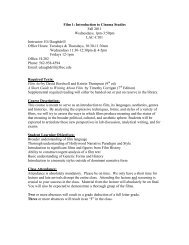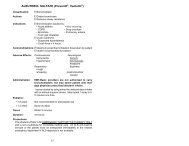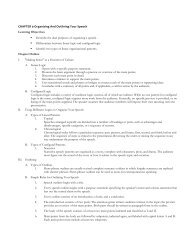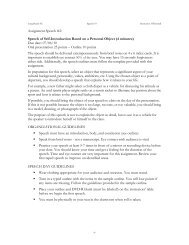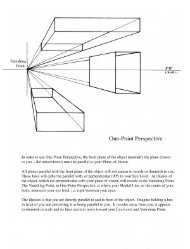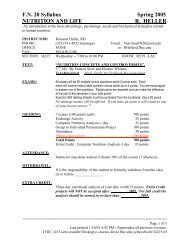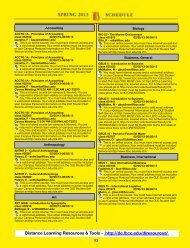COURSE SYLLABUS For Clinical Content Spring 2012
COURSE SYLLABUS For Clinical Content Spring 2012
COURSE SYLLABUS For Clinical Content Spring 2012
You also want an ePaper? Increase the reach of your titles
YUMPU automatically turns print PDFs into web optimized ePapers that Google loves.
SKILL LAB: Tube FeedingBEHAVIORAL OBJECTIVES - NURSING PROCESS APPLICATION1. Assessmenta. Identify client health deviations and medical treatment regimens associatedwith enteral feedings.b. Describe the appearance and location of a gastric tube (GT) and anasogastric tube (NGT) on the patient's body.c. Identify bedside equipment needed with intermittent (bolus) feedings andfor continuous feedings.d. Briefly identify commonly used tube feeding formulas and food. Describe atypical treatment order for such feedings.e. Describe assessments to determine adequacy of fluid intake.f. Identify fecal elimination problems associated with tube feedings.2. Planninga. Identify the expected outcomes of tube feedings.I. Identify the risk factors associated with tube feedings, and the nursinginterventions designed to prevent complications.II.Differential between the nursing interventions required whenadministering any fluids through a GT as opposed to those required whenadministering fluids through a NGT.3. Implementationa. Discuss medical asepsis and Standard Precautions as they apply to enteralfeedings.b. Position patient with head of bed up to at least 45 degrees.c. <strong>For</strong> N/G tube, perform two checks for proper placement of the tube:aspiration of gastric contents and auscultation of air.d. <strong>For</strong> G- tube and NG tube, aspirate stomach for residual and if more than 50ml, do not proceed with the feeding.e. Administer feeding by bolus or drip, as ordered.f. Adjust drip rate or speed as appropriate.g. Document procedureCRITICAL ELEMENTS:1. Protects self and others from contamination during administration of tube feeding.2. Position patient with HOB up at least 45 degrees.3. Perform two checks for placement of tube.4. Verbalize amount aspirated and state rationale for proceeding or discontinuingfeeding.5. Use equipment appropriately to prevent air from entering the stomach duringfeeding.STUDENT RESPONSIBILITIES:1. Come to lab prepared to discuss behavioral objectives and critical elements fornasogastric tube feeding, textbook pages read, skill lab and assessment sheet read.2. Perform steps as directed by instructor in supervised lab.3. Practice independently or with requested teacher assistance in preparation forassessment of nasogastric tube feeding.33.0



